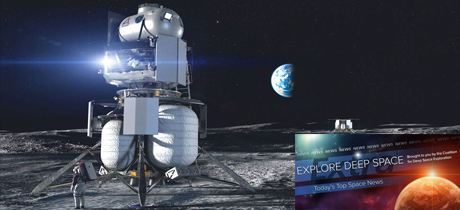In Today’s Deep Space Extra… NASA and commercial partner leadership discuss unfolding strategies for how and where they might return to the surface of the Moon in 2024. Within a month, the European/Japanese Bepi-Columbo spacecraft will flyby Venus with instrumentation ready for another look at indications of atmospheric phosphine, a biomarker. NASA auditors raise concerns about oversight and funding of the agency’s ambitious planetary science division agenda.
Human Space Exploration
Lueders adds to mystery of Artemis 3 landing site: “More to come”
Coalition Member in the News — Dynetics
Spacepolicyonline.com (9/16): During remarks Wednesday before the Washington Space Business Roundtable, Kathy Lueders, NASA’s recently appointed Associate Administrator for Human Exploration and Operations, reinforced comments from Administrator Jim Bridenstine on Monday that the agency’s return to the Moon with human explorers planned for 2024 may occur near a previous Apollo landing site rather than at the more challenging lunar south pole. The agency is considering “a bunch of different options for making a decision,” said Lueders.
Dynetics to use in-space refueling for NASA lunar lander
Coalition Members in the News — Dynetics, Lockheed Martin, Northrop Grumman, United Launch Alliance
SpaceNews.com (9/16): On Tuesday, Dynetics unveiled its version of a commercial human lunar lander system and provided an overview of proposed operations before an AIAA webinar. Dynetics is one of three company-led teams currently competing under NASA’s lunar Human Landing System (HLS) initiative to provide a means of shuttling astronauts between lunar orbit and the surface of the Moon. Three launches of hardware in rapid succession and in space refueling would be required to reach lunar orbit under the Dynetics strategy. The action would start with NASA’s Artemis initiative and Artemis 3, a mission to return human explorers to the surface of the Moon in 2024. Teams led by Blue Origin and SpaceX are also competing.
Space Science
IG audit: NASA planetary program faces major financial, managerial challenges
Parabolicarc.com (9/16): An audit of NASA’s Planetary Science Division by the agency’s inspector general raises questions over funding and oversight as it prepares to tackle an ambitious agenda of future missions, including a return of rock and soil samples from Mars as well as missions to Jupiter’s moon Europa and Saturn’s moon Titan. All three destinations could offer new insight into whether some form of life arose beyond the Earth. NASA may also be challenged to achieve a Congressional benchmark for the discovery and tracking of asteroids and comets that pass close enough to the Earth to pose potential impact threats.
OHB to build ESA’s Hera asteroid mission
SpaceNews.com (9/16): OHB, the Germain satellite manufacturer, has scored a $153.3 million European Space Agency (ESA) contract to develop Hera, which is to launch in October 2024, to participate in NASA’s Double Asteroid Redirection Test, or DART, mission. DART is a demonstration of an impact strategy to alter the trajectory of an asteroid on a course to collide with the Earth. The target is an asteroid pair, Didymos and Dimorphos. DART is to launch next July and impact Dimorphos in September 2022. Hera will arrive to provide a followup assessment.
NASA missions spy first possible ‘survivor’ planet hugging white dwarf star
NASA Goddard Space Flight Center (9/16): Working with NASA’s Transiting Exoplanet Survey Satellite (TESS) and the now retired Spitzer space telescope, an international team of scientists has spotted what appears to be a planet orbiting a white dwarf star. White dwarfs are the remnant of sunlike stars that have exhausted their fuel and exploded. The star relic, WD 1856+534, is just 40 percent the size of the Earth. The Jupiter sized planet, WD 1856 b, is seven times as large as the white dwarf.
Two asteroids safely buzzed close by Earth this week
Space.com (9/16): It happened on Monday. Asteroid 2020 RF3 and 2020 RD4, sailed safely past the Earth, the first at a distance of 58,500 miles and the second at 65,700 miles, or well within the orbit of the Moon.
In a complete fluke, a European spacecraft is about to fly past Venus and could look for signs of life
Forbes.com (9/16): An international team of scientists caused a stir on Monday when they announced findings from observations of Venus with telescopes on Earth that detected the presence of phosphine gas in low concentrations in the upper atmosphere. One explanation for the source could be biologic activity. The scientists called for further analysis, perhaps a new spacecraft mission. However, Bepi Columbo, a Japanese and European mission launched in 2018 to Mercury, must swing past Venus in order to slow down and will do so on October 15 and again on August 10, 2021. Each flyby will permit a European spectrometer on Bepi Columbo to look up close for more evidence of phosphine in the upper atmosphere of Venus and a possible source.
Other News
NASA and Energy Department step up cooperation
SpaceNews.com (9/17): During a University of Tulsa hosted roundtable on Wednesday, executives from NASA and the Department of Energy, discussed their intentions to work closely on future efforts to improve photovoltaics, the technology for solar array electricity generation; a ground observatory capable of assessing Near Earth Objects with an Earth impact potential and lunar science. Already, the two agencies are working on technology for a nuclear power source for the surface of the Moon.
CSF president to join Voyager Space Holdings
SpaceNews.com (9/17): The longtime president of the Commercial Spaceflight Federation (CSF) is stepping down next month to become an executive with one of the organization’s member companies. The CSF announced September 17 that Eric Stallmer will leave the organization in late October to become executive vice president for government relations and public policy at Voyager Space Holdings, a holding company that is acquiring a number of space startups. Stallmer has been president of CSF since 2014.

